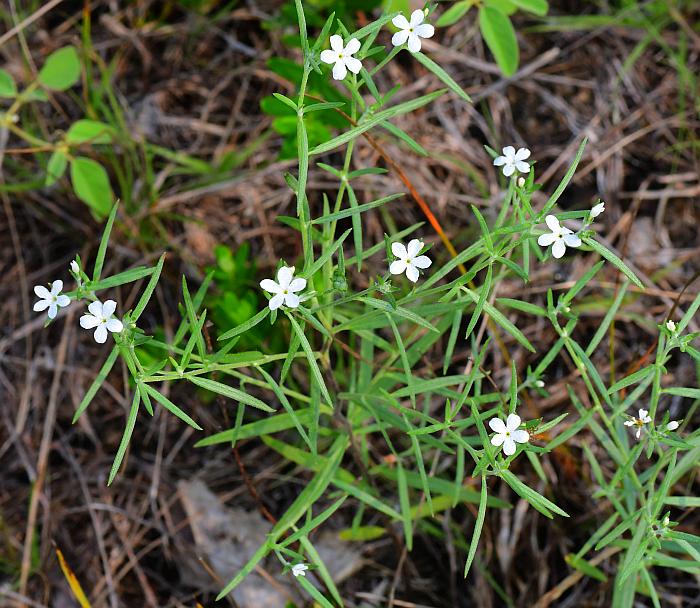Heliotropium tenellum Torr.
Pasture Heliotrope

Native
CC = 8
CW = 5
MOC = 57
© SRTurner
Heliotropium tenellum Torr.Pasture Heliotrope | |
 |
Native CC = 8 CW = 5 MOC = 57 |
© SRTurner |
|
Family - Heliotropiaceae Habit - Annual forb with a slender taproot. Stems - Ascending to erect, to 40 cm, usually well branched, canescent, densely pubescent with straight, appressed, nonglandular, white hairs.
Leaves - Alternate, simple, short-petiolate to sessile. Petioles to 3 mm long. Blades 0.8-4.0 cm long, 1-3 mm wide, linear, tapered at the base, angled or tapered to a sharply pointed tip, with a single midrib, the margins entire, sometimes rolled under, the surfaces moderately to densely pubescent with straight, appressed, nonglandular, white hairs.
Inflorescence - Solitary flowers at the tips of short branches, sometimes appearing as small clusters, each flower with a noticeable stalk 2-5 mm long, lacking bracts (but the larger calyx lobes appearing bractlike).
Flowers - Calyces deeply lobed, the lobes very unequal, 2-6 mm long, all linear and similar in appearance to the leaves, ascending after the fruit has dispersed. Corollas 5-lobed, 4-5 mm long, 3-5 mm in diameter, funnel-shaped to more or less trumpet-shaped, white, sometimes with a light yellow spot at the base of the lobes, hairy on the outer surface of the tube and with a hairy central band on the outer surface of each lobe, the tube 2-3 mm long, glabrous on the inner surface, the lobes 1.3-1.7 mm long. Stamens 5, attached at the base of the tube, the anthers 0.7-1.2 mm long. Stigma on a short style, the sterile appendage narrowly conic, sharply pointed and often minutely notched at the tip, glabrous. Ovary superior, globose, green, 0.3 mm in diameter. Style minute.
Fruits - Dry, drupelike, 1.5-2.5 mm long, 2.5-3.0 mm wide, broadly ovoid to depressed-globose, finely hairy, splitting into 4 1-seeded nutlets. Nutlets with the dorsal surface finely hairy, at least toward the base, otherwise smooth to shallowly pitted, yellowish brown to dark brown.
Flowering - July - October. Habitat - Glades, tops of bluffs, dry upland forest openings, quarries; on limestone and dolomite substrates. Origin - Native to the U.S. Lookalikes - Buglossoides arvensis, Houstonia nigricans, H. longifolia. Other info. - This little species is common in the Ozark region of Missouri, rare or absent in the northwestern third of the state and the Bootheel region. Beyond Missouri its range is mainly restricted to five states to our south and west, with a small additional band through central Kentucky and southward. The plant is relatively easily identified by its wispy, canescent foliage and small white flowers. These have five corolla lobes, which serves to differentiate this plant from species of Houstonia, which have 4-lobed flowers. There is also resemblance to Buglossoides arvensis, which is typically a somewhat larger, more robust plant with wider leaves, and which is found in much different, usually disturbed, habitats. Heliotropium tenellum has a high coefficient of conservatism and is not found in disturbed sites. It is strongly correlated with calcareous glades. Photographs taken at the Peck Ranch Wildlife Refuge, Carter County, MO., 7-12-03 (DETenaglia); also at Shaw Nature Reserve, Franklin County, MO, 6-22-2007 and 7-16-2023, St. Joe State Park, St. Francois County, MO, 9-12-2012, and Glade Top Trail National Scenic Byway, Ozark County, MO, 8-15-2023 (SRTurner). |